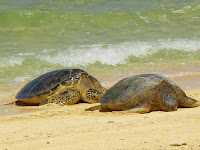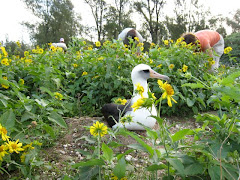
THE NIGHT RANGER AND PAA PETROL PATROL
By Hugh Story
6/17/2010
EGG-SPRESS YOURSELF
A clear night speckled with limitless stars blanketed our Wednesday night and our group was giddy after an afternoon of sifting through albatross boluses and starting our own Olympics-bound Synchronized Cargo Pier Jumping Team. Lookout Slovenia!
Led by U.S.Parks and Wildlife Services Manager Tracy Ammerman, our group set off to complete our mission: Locate a young ‘Ua’u, otherwise known as the Bonin Petrel, during a leisurely night’s stroll through the roads of Midway Atoll.
Although similar in sound, it should not be confused with petrol. The Bonin Petrel or Pterodroma hypoleuca, is an endemic bird to the Midway Atoll. I found it to not a particularly graceful bird when it comes to walking, as the Petrel can often be found stumbling about like a man making his way home after a night of heavy drinking. But still a beautiful bird nonetheless.
The journey started out safe enough but we would soon find out otherwise.
“Crack!”
“Splat!”
“Oh my God! What was that!?”
“Get the light! Get a light!”
An egg had just come out of nowhere and several members of the group just got yoked. We attempted to CSI the situation, putting forth several theories but no culprit was located. It was written off as a prank pulled off by adolescent teenage birds out blowing off some steam. Toilet paper and shaving cream didn’t follow so we continued.
Eureka! We found one. Tracy, our Night Ranger, walks over and scoops up the confused Petrel who must have been dazed with all the onlookers around it. We examined its docile behavior and white, black and grey feathers. It was magnificent. Our mission was a success allowing us to prove once again that a ‘bird in the hand is…” well you know how the rest goes.
THE BARKING BUSH AND AVE MARIA
“Ummm..did that bush just bark at me?”- I inquired to one of my fellow patrolman, certain that I had perhaps ingested too much Orange Tang over the last few days. But that wasn’t so…the bush WAS barking in a way along with a variety of other calls of birds found on the atoll. We had arrived at the sound station designed to imitate the sounds of native birds to assist in pairing. The Bulwer’s Petrel, or Bulweria bulwerii, is known for its distinctive sound to that of a barking dog.
Next to the sound station, was a shrine with “Ave Maria” inscribed on it. That thing too would not be immune to our photography as we began snapping pictures of it in assembly line fashion. I found it all to be a bit surreal…boluses, birds, barking bushes and a Hail Mary but a perfect way to end a magical day on Midway Atoll.
Anyone with information about the recent egging is asked to call us.





























